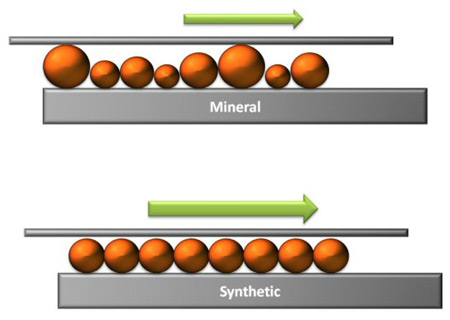Synthetic oils
Oil is one of the most important components in a modern race engine, but it rarely appears in the limelight in the way power-enhancing components do. Beyond the realms of historic racers, which still use the beautifully aromatic caster oil blend of Castrol R, race engines will run on fully synthetic oils. It would be fair to say that without the development of synthetic-type oils, the levels of performance and reliability achieved from, for example, a Formula One V8, would not be possible. These engines rely on the low viscosity and temperature resistance of bespoke oil blends, which are only achievable using synthetic, as opposed to mineral, oils. So what makes up synthetic oil?
All oils are made from a 'base stock', but while traditional mineral oils are derived from crude oil, the same is not true of all synthetic oils; the 'synthetic' refers to the fact that the oil has been manipulated at the molecular level to change its properties. This can either be manipulation of highly refined mineral stocks (originating from crude oil) or from man-made base stock derived from sources such as natural gas or esters.
The list below shows the different types of base oils. Many synthetic oils on the market are produced from hydro-cracked Group III stocks; however, for motorsport-specific oils only groups 4 and 5 will normally be used.
There are five families of base oil:
- Mineral oil Group I - conventional base oil derived directly by refining crude oil
- Mineral oil Group II - as above but more highly refined
- Hydrocracked Group III- extra highly refined base stocks
- PAO Group IV - pure synthetic hydrocarbon (SHC)
- Esters Group V - fully synthesised from a reaction between acids and alcohols.
These base stocks will have a very uniform molecular structure, as shown in Fig. 1, which allows them to perform far more consistently as a lubricant. This is important, because the base stock, even with the inclusion of additives, is responsible for the majority of lubrication properties in an oil.
The key advantages of synthetic base oils from a race engine designer's perspective is their improved temperature resistance, heat rejection and film strength characteristics.
Synthetics are simply more tolerant than petroleum oils to extreme heat. When heat builds up in an engine, petroleum oils quickly begin to burn off. They are more volatile; the lighter molecules within petroleum oils turn to gas, and what's left are the large molecules that are harder to pump. Synthetics have far more resistance as they are more thermally stable to begin with, and can withstand higher temperatures for longer periods without losing viscosity, a characteristic that can be further enhanced by including viscosity-modifying additives.
The uniformly smooth molecular structure of synthetic oils also gives them a much lower coefficient of friction than mineral oils - and less friction means less heat. Also, since each molecule in a synthetic oil is of uniform size, each is equally likely to touch a component surface at any given time, thus moving a certain amount of heat into the oil stream and away from the component. This makes synthetic oils far better heat transfer agents than conventional petroleum oils.
Mineral oils have very low film strength in comparison to synthetics. The film strength of a lubricant refers to its ability to maintain a film of lubricant between two objects when extreme pressure and heat are applied. This is especially important where lubrication is marginal, such as around main bearing shells or at the camshaft- lifter interface. Synthetic oils will typically have a film strength five to ten times higher than that of mineral oils of comparable viscosity. Even though heavier weight oils usually have higher film strength than lighter weight oils, an SAE 30 or 40 synthetic will typically have a higher film strength than an SAE 50 or 60 petroleum oil.
Different oil suppliers will have their own synthetic base stocks, and these will be used as the foundation of motorsport-specific synthetic blends. It is from this starting point that chemical engineers will begin to modify the oil to provide specific characteristics. The level of this 'customisation' will vary depending on the final user: a general motorsport oil for modern multi-valve engines will have an additive pack that can be used across a range of engines, whereas oil destined for a Formula One team will have an additive pack tailored exactly to their engines' specific needs. Next time we look at oils, we will investigate these additives further.

Fig. 1 - A representation of the molecular make-up of mineral-based and synthetic oils
Written by Lawrence Butcher